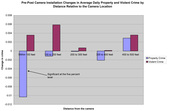Highlight
Evaluating the Crime Deterrent Effects of Crime Surveillance Cameras
Achievement/Results
Using quasi-experimental evaluation methods commonly employed in economics and political science research, Amy Lerman, Steven Raphael, and Jasjeet Sekhon evaluated whether the installation of surveillance cameras by the San Francisco Police Department reduced crime in high crime neighborhoods. The study employed a careful research design that defined quasi-experimental treatment and control areas based on the geocoded distances of crime incidents from camera locations. Presumably, if potential criminal offenders are deterred by the presence of a camera, one would expect to see declines in areas within the immediate vicinity of a camera. Areas outside of the camera’s view shed should not experience such declines. Since the areas immediately outside these areas are subject to similar crime fundamanetals (similar policy patrols, similar neighborhood characteristics) these slightly more distant areas serve as a natural comparison group for the areas withini the immiediate vicinity of a camera.
The study documents declines in property crime (in particular, larceny thefts such purse snatchings and car break-ins) within 100 feet of the camera. There are no comparable declines (or increases) beyond the 100 foot radius, suggesting that the cameras do indeed reduce property crime. There were no similar patterns for violent crime, although homicide declined within the immediate vicinity of the camera, but increased in areas down the street from these cameras.
Address Goals
Our IGERT strives to pull the behavioral modeling from economics and psychology, the evaluation methods from economics, applied statistics and political science, and the implementation analysis from political science to study policy relevenat questions that are both useful to policy makers yet advance the social sciences. The discussed research highlight applies an inter-discplinary took kit (quasi-experimental analysis and the reasining of economic behavioral modeling) towards the evaluation of an important anti-crime initiative that has been implemetned in variaous cities around the country (including San Francisco, Chicago, Washington DC and Boston, to name a few). The resutls advance the literature on behavioral responses to deterrents while providing useful information to policy makers regarding a pilot program.






